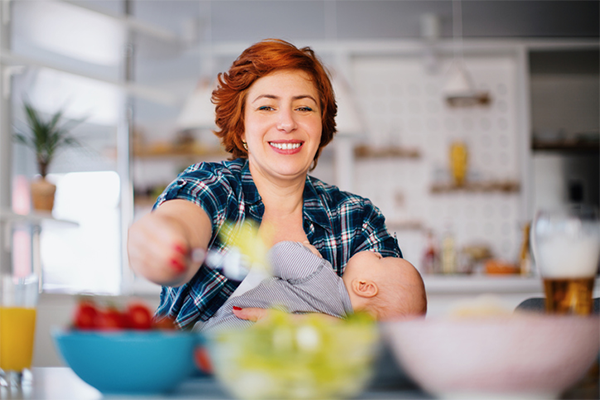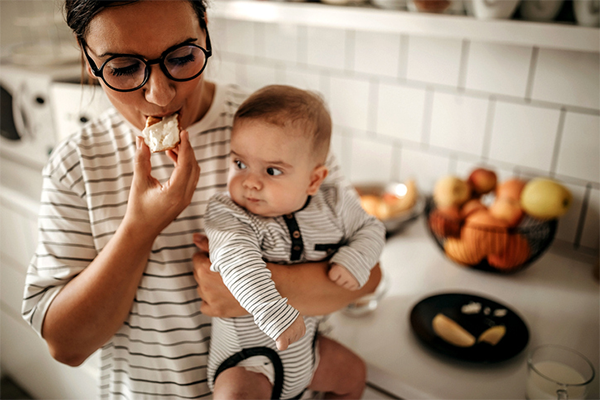A lot is made of the odd dietary combinations that result from cravings during pregnancy, but comparatively little is devoted to how should you eat while breastfeeding.
While the “eating for two” mindset gets an overdue makeover in our nutrition program, 2B Pregnant, lactating mothers do need extra calories. Let’s explore where they should come from.
How Many Calories Should You Eat While Breastfeeding?
Mothers who are nursing require an additional 330 calories in the first six months and 400 calories in the second, per day, per infant, according to the Centers for Disease Control and Prevention (CDC).
These calorie counts assume a healthy pre-pregnancy weight, and represent about two-thirds of the calories needed to make enough milk for most babies. (The remainder comes from the weight gained during pregnancy.)
“Some nursing mothers will lose weight during breastfeeding due to the high energy demands required to produce breastmilk,” says Krista Maguire, R.D.N., senior nutrition manager for BODi. “Fat stores can be used to fuel this production as well as help make up the fat content of your baby’s milk.”
Of course, the exact number of calories needed to breastfeed can depend on a variety of factors, including the mother’s body mass index (BMI) and activity level, and whether the baby is receiving any additional forms of sustenance, such as formula or baby food.
Best Foods to Eat While Breastfeeding
The USDA guidelines on what to eat while breastfeeding mostly resemble those for any healthy diet, with a few additional considerations.
1. Protein
Lean meat, eggs, dairy, beans, lentils, and a variety of seafood that is low in mercury.
2. Whole fruits (as opposed to dried fruit, juices, jams, etc.)
Apples, berries, oranges, peaches, pears, and bananas.
3. Vegetables
Broccoli, potatoes, beets, spinach, carrots, peppers, and brussels sprouts.
4. Whole grains
Wild rice, oats, rye, spelt, and whole-wheat bread and pasta.
5. Low-fat dairy
Milk, yogurt, cheese.
The most important thing for breastfeeding moms is to maintain a well-balanced diet, says NorthShore University HealthSystem OB/GYN Dr. Ann Borders. Maguire adds that mothers should start by getting at least 1,800 calories per day via a variety of the above foods to ensure their babies get a full range of nutrients.
There are some specifics to be mindful of when getting those nutrients, due to 1. Their importance for the infant, and/or 2. Their insufficiency in some lactating women. These include:
- Protein
- Omega-3 fatty acids
- Calcium
- Vitamin D
- B vitamins (including folate)
- Iodine
- Choline
- Magnesium
- Potassium
- Dietary fiber
According to the CDC, a mother’s need for iodine and choline in particular increases during lactation. So, the USDA recommends getting 290 mcg of iodine and 550 mg of choline a day during the first year of motherhood. Sources of iodine include dairy, eggs, seafood, and iodized table salt, while choline can be found in eggs, dairy, meats, and some seafood and legumes.
Bonus tip: Diversifying your food sources, as Borders and Maguire advise, has the added benefit of exposing your child to a fuller range of tastes and flavors. That may make them more receptive to new foods later in their development.
Foods to Avoid While Breastfeeding
A 2017 literature review didn’t find any foods that mothers should avoid while breastfeeding, excepting those that elicited adverse reactions from the infant. That said, lactating mothers are best advised to limit their consumption of the following items.
- Alcohol: abstinence is ideal, but one drink per day is the maximum, waiting at least 2 hours before nursing.
- Caffeine: maximum 300 mg per day (approx. 2 to 3 cups coffee)
- High-mercury fish: skip; instead opt for 2 to 3 servings per week of fish lower in mercury
It’s also generally a good idea to limit foods and beverages that are high in added sugars, saturated fat, and sodium.
Breastfeeding Tips for Vegans and Vegetarians
“When women are vegetarian or vegan, it’s a good idea to meet with a nutritionist or dietitian to make sure they’re on track to meet the dietary needs of their babies,” Borders says, noting the particular importance for these women of the following nutrients:
- Protein
- Iron
- Omega-3s
- Vitamin D
- Iodine
- Calcium
- Vitamin B-12
Similar concerns apply to breastfeeding women who are interested in maintaining or revisiting their pre-pregnancy eating patterns, oftentimes in the interest of shedding pregnancy weight and getting back into shape fast.
Breastfeeding and Weight Loss
Though not every woman reports weight loss while breastfeeding, it can certainly help the cause for some.
“Typically, prolonging breastfeeding really helps women get back to their pre-pregnancy weight, while also lowering the rates of obesity, diabetes, and cardiac disease,” Borders says.
The biggest reason, in Borders’ opinion?
“By breastfeeding for longer, you’re helping to morph those fat reserves in your body into the energy needed to produce breastmilk,” she says.
Still, it’s all the more reason to go easy on the extra calories — unless you really need them.
“Our bodies should’ve already done a good job of putting fat reserves together during pregnancy months,” says Borders, who provides a bottom line that can work for everyone:
“I always just tell women to 1. Maintain a healthy diet, 2. Eat when you’re hungry, and 3. Don’t go too crazy with additional calories. Just focus on a well-balanced diet to meet the needs of yourself and your baby.”


